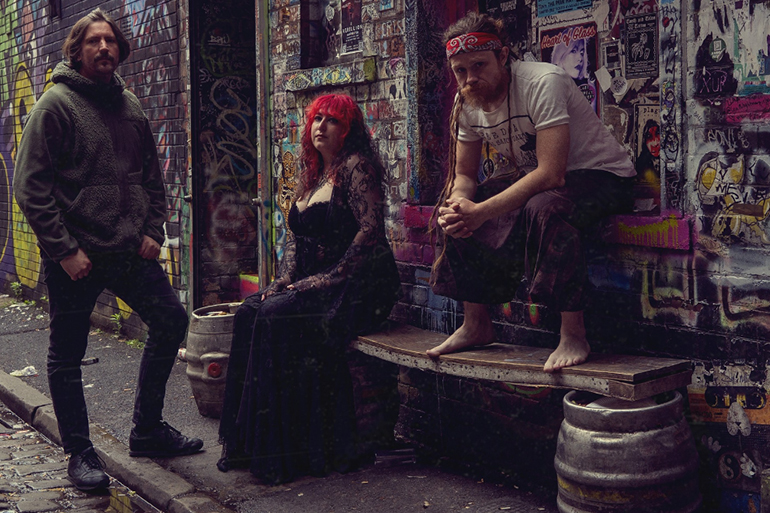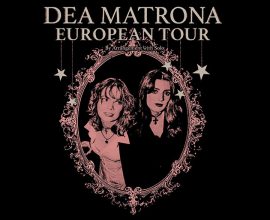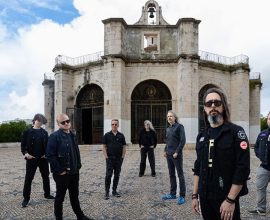Dawnwalker: “This album is a guided meditation through life, death, and everything in between”
With “The Between”, Dawnwalker present a unique musical experience: a guided meditation on death and dying, where instrumental and spoken word intertwine to lead the listener through an introspective journey. Inspired by Eastern philosophies, particularly the Tibetan Book of the Dead, the album explores rites of passage, life, death, and transcendence, translating these reflections into a continuous 32-minute composition that unfolds across multiple movements without losing cohesion or flow.
By Sandra Pinto
Recorded at Holy Mountain and produced by Stanley Gravett and Scott McLean, the album blends post-metal, doom, and new age influences, expanding the band’s sound to include synthesizers, saxophone, harmonium, voices, and diverse percussion. The result is a work that functions as a space for contemplation, where emotional extremes — from grief to celebration — are explored to reach balance and introspection. The album artwork, created by Nicole Frobusch, visually reflects human fragility and the beginning of this journey between worlds, complementing the philosophical depth of the music. All answers in this interview are provided by Mark Norgate.
The Between is described as a “guided meditation through death and dying.” What inspired this deeply philosophical approach, and how did you incorporate ancient Eastern philosophies into the composition?
For the past few years I’ve been very occupied with reading about different religious practices, especially the more niche or esoteric ones. One thing in particular that interests me is death rituals and what different cultures think about what happens to us when we die. Probably the
most influential was the Tibetan Book of the Dead (Bardo Thodol) which we took many cues from. It acts as a guide for a dying person as they navigate their way to the other side.
This album features a unique 12-piece lineup and an expanded sound. Can you share how each musician’s contribution helped shape the final product, especially in terms of blending post-metal, doom, and new age influences?
We really wanted to expand the sound of this album beyond the typical rock/metal lineup in order to create a special mood, so there are a lot of percussion instruments, synths, voices and some instruments we’ve never used before like a saxophone and harmonium. We wanted it to
feel like an epic journey, and have variety and feel like the listener is transported to a place between worlds where the usual modes of operating are suspended.
The idea of a long-form, album-length song is something you’ve explored before, but this release seems to take it to a new level. Can you walk us through the process of writing a 32-minute composition that is cohesive and flows naturally from one movement to the next?
This was a challenge we set for ourselves to start from the beginning and write through to the end in a “through-composed” fashion. We’d never done it before so it was a nice challenge for us, but also I feel that the piece wouldn’t have felt complete if we’d worked in another way and just joined a few disparate ideas together. It had to feel like a journey that unfolds at its own pace and has consistency throughout.
You mentioned that the album is meant to be cathartic and joyful, yet it explores the darker regions of the psyche. How do you balance these contrasting emotions throughout the piece?
There is a lyric near the beginning that basically says that ‘heaven and hell are the same’ which is a key idea in the kinds of philosophies that we were exploring. Ultimately, the goal is to end up balanced and in the centre and at peace, but you have to explore the extremes, the highs and the lows, the dark places to be able to reach that place. We really tried to capture a wide range of emotions, the good, bad and the ugly. In a way, we tried to put every aspect of our music into one song.
The production of The Between was handled by Stanley Gravett and Scott McLean, both of whom have strong ties to atmospheric, immersive sounds. What role did the production play in enhancing the album’s themes of death, meditation, and existential despair?
We took a very naturalistic approach which is a path we’ve been continuing on for a few years now. While we didn’t all perform live together at the same time, we wanted to create a natural feeling of all the instruments in the same space and a kind of honest reproduction of what we
really sound like. I feel it’s one of our best sounding albums and the most organic and natural, we’re very pleased with it.
Can you speak about the decision to have an ambient bonus track, “Remember Death”? How does it deepen the philosophical themes of The Between, and why was it kept as an exclusive release for Bandcamp and Ampwall?
The bonus track functions as a kind of explanation of the ideas that we explore in The Between so in a way it’s a kind of spoiler or a footnote. I was in two minds about whether to release it or just let the main piece stand on its own and let people interpret it how they like. In the end we
decided to include it as a bonus track for our fans who choose to support us most directly through our own sites – BandCamp, Ampwall, etc.
Mark, you’ve mentioned in previous interviews that you wanted to create a composition that functions as an entire album. In doing so, what is the overarching message of The Between and how do you want listeners to experience the journey?
If there is a message I guess it’s that death is a part of life and it affects us all, so it’s worth meditating upon and thinking about. In the west, we tend to treat death as something not to be spoken about, and it comes as a shock and a surprise to us at the end of life. The Between can
function as a sort of space to ponder upon these ideas. But ultimately, I hope people take away their own interpretation and make of it what they will.
The use of a narrator throughout the piece is an interesting choice. How did you decide to incorporate spoken word into the composition, and how does it complement the instrumental parts of the song?
The narrator acts as a sort of spirit guide and keeps us focused as a listener. While some sections are more direct, it was important for the piece to have some sections which feel meandering or unfocused for a time, allowing the attention to wander, and the narration usually helps to guide us back onto the path when the time comes.
This album was recorded at Holy Mountain and mixed by Scott McLean. What was it about those particular environments that contributed to the unique sound of The Between?
Holy Mountain has a philosophical approach of capturing real performances and sounds in the room with minimal editing and studio trickery, which suits us well. I want our music to be honest and show people our best side but also not airbrush out all of our personality and quirks, flaws, etc. It’s easy nowadays to edit, clean up, make everything too perfect but to me it can stop music feeling human. Scott also has made many records which we love the sound of and he just gets what we’re going for.
Looking ahead, what’s next for Dawnwalker? Are there any plans to perform this long-form piece live, and how would you approach a performance that mirrors the depth and emotional journey of the album?
We’d love to perform the piece live next year and we’re thinking about how best to do it at the moment. We obviously can’t do it with a 12-piece band, especially not for the size of shows and stages we usually play on! But I’m sure there’s a way we can bring it to life in a live context and still retain the rich atmosphere so we’ll hopefully have some news about this very soon.
The album artwork, painted by Nicole Frobusch, is striking and visually complex. How do the themes in the cover art relate to the music itself, and what message or feeling do you hope the visual elements convey to listeners?
I absolutely love the piece and for me it represented everything I wanted it to say. I see a human form, aging and death, bodily fluids, the body breaking down and a soul leaving its body. It also has a kind of a psychedelic aspect to it while being intensely human and a reminder of the
fragile bodies we inhabit. It also to me suggests the very moment of the beginning of the journey.
Bandcamp here.





